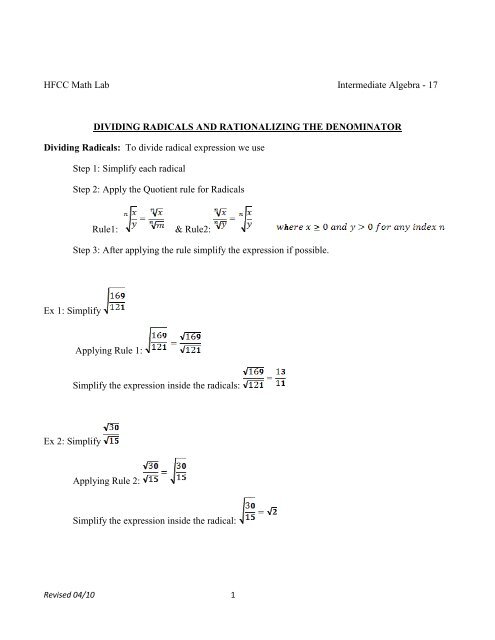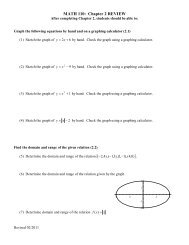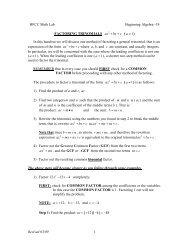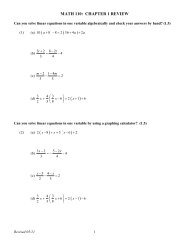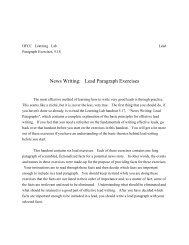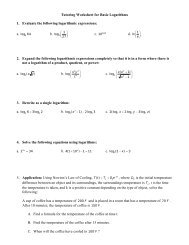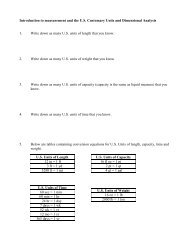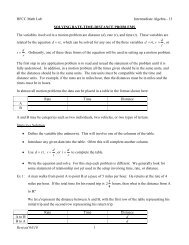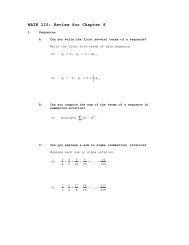Dividing Radicals and Rationalizing the Denominator
Dividing Radicals and Rationalizing the Denominator
Dividing Radicals and Rationalizing the Denominator
You also want an ePaper? Increase the reach of your titles
YUMPU automatically turns print PDFs into web optimized ePapers that Google loves.
<strong>Rationalizing</strong> <strong>the</strong> <strong>Denominator</strong>: In order for a radical expression to be in <strong>the</strong> simplest radical form,<strong>the</strong>re can be no fractions under <strong>the</strong> radical sign <strong>and</strong> no radicals in <strong>the</strong> denominator of <strong>the</strong> fraction. Theprocess of removing <strong>the</strong> radicals from <strong>the</strong> denominator is called rationalizing <strong>the</strong> denominator.A. <strong>Rationalizing</strong> <strong>the</strong> denominator when <strong>the</strong> denominator has only one term with index nStep 1: Simplify any radicals in <strong>the</strong> numerator <strong>and</strong> <strong>the</strong> denominator.Step 2: Determine <strong>the</strong> factor needed to make <strong>the</strong> denominator radic<strong>and</strong> a perfect n th powerStep 3: Multiply <strong>the</strong> numerator <strong>and</strong> denominator with <strong>the</strong> factor determined in step 2Step 4: Simplify <strong>the</strong> resulting expression if possibleEx 5: Rationalize <strong>the</strong> denominatorStep 1: Simplify <strong>the</strong> radicalStep 2: The factor required to make <strong>the</strong> denominator radic<strong>and</strong> a perfect 2 nd power isStep 3: Multiplying <strong>the</strong> numerator <strong>and</strong> denominator by :Step 4: Simplify <strong>the</strong> resulting expression:Ex 6: Rationalize <strong>the</strong> denominatorStep 1: Simplify <strong>the</strong> radicalStep 2: The factor required to make <strong>the</strong> denominator radic<strong>and</strong> a perfect 3 rd power isStep 3: Multiplying <strong>the</strong> numerator <strong>and</strong> denominator by :Revised 04/10 3
Step 4: Simplify <strong>the</strong> resulting expression:Ex 7: Rationalize <strong>the</strong> denominatorStep 1: Simplify <strong>the</strong> radicalStep 2: The factor required to make <strong>the</strong> denominator radic<strong>and</strong> a perfect 3 rd power isStep 3: Multiplying <strong>the</strong> numerator <strong>and</strong> denominator by :Step 4: Simplify <strong>the</strong> resulting expression:Ex 8: Rationalize <strong>the</strong> denominatorStep 1: Simplify <strong>the</strong> radicalStep 2: The factor required to make <strong>the</strong> denominator radic<strong>and</strong> a perfect 3 rd power isStep 3: Multiplying <strong>the</strong> numerator <strong>and</strong> denominator by : =Step 4: Simplify <strong>the</strong> resulting expression:Revised 04/10 4
B. <strong>Rationalizing</strong> <strong>the</strong> denominator with two terms, one or both of which involve square root.Recall that <strong>the</strong> binomials <strong>and</strong> are called <strong>the</strong> conjugates. And <strong>the</strong> difference of squareformula <strong>the</strong> product of <strong>the</strong> conjugates will result in .Step 1: Multiply <strong>the</strong> numerator <strong>and</strong> denominator by <strong>the</strong> conjugate of <strong>the</strong> denominatorStep 2: Simplify <strong>the</strong> resulting expression if possibleEx 9: Rationalize <strong>the</strong> denominatorStep1: Multiplying <strong>the</strong> numerator <strong>and</strong> denominator with <strong>the</strong> conjugateof <strong>the</strong>denominator:Step 2: Simplify:Ex 10: Rationalize <strong>the</strong> denominatorStep1: Multiplying <strong>the</strong> numerator <strong>and</strong> denominator with <strong>the</strong> conjugateof <strong>the</strong>denominator:Step 2: Simplify:Ex 11: Rationalize <strong>the</strong> denominatorStep1: Multiplying <strong>the</strong> numerator <strong>and</strong> denominator with <strong>the</strong> conjugateof <strong>the</strong>denominator:Step 2: Simplify:Revised 04/10 5
Exercises: Rationalize <strong>the</strong> denominator in each of <strong>the</strong> following. Assume that <strong>the</strong> variable arepositive <strong>and</strong> <strong>the</strong> denominator is equal to zero9. 10.11.13.12.14.15. 16.17.18.19. 20.21. 22.23.24.Solutions to <strong>the</strong> Exercise problems:Exercises: Divide <strong>and</strong> simplify using <strong>the</strong> following radical expressions1.= ==3.= ==2.= ===4.= ==Revised 04/10 6
5.= ==6.= ==7.==8.==9.==10.==11.=12.==13.==14.==Revised 04/10 7
15.==16.==17.==18.==19.==20.==21.==22.==23.==24.==Revised 04/10 8
You can get additional instruction <strong>and</strong> practice by going to <strong>the</strong> following websitehttp://www.purplemath.com/modules/radicals5.htm This website provides goodreview <strong>and</strong> practice problems for quotient rule <strong>and</strong> rationalizing <strong>the</strong> denominatorhttp://www.wtamu.edu/academic/anns/mps/math/mathlab/int_algebra/int_alg_tut40_addrad.htm This website provides good review <strong>and</strong> practice for rationalizing <strong>the</strong>denominatorhttp://www.helpalgebra.com/articles/rationalizedenominator.htm This websiteprovides good review <strong>and</strong> practice for rationalizing <strong>the</strong> denominatorRevised 04/10 9


